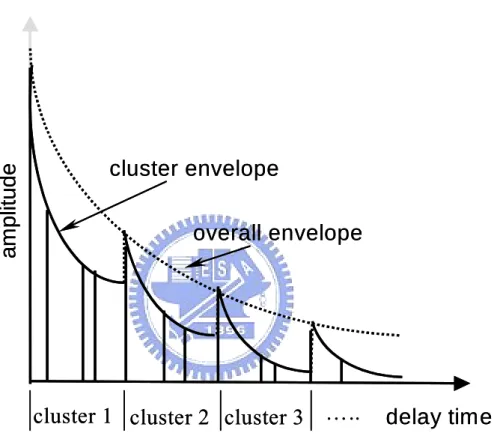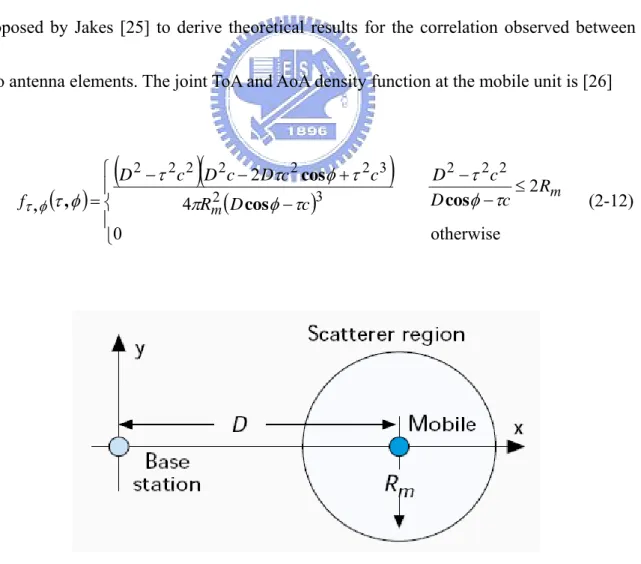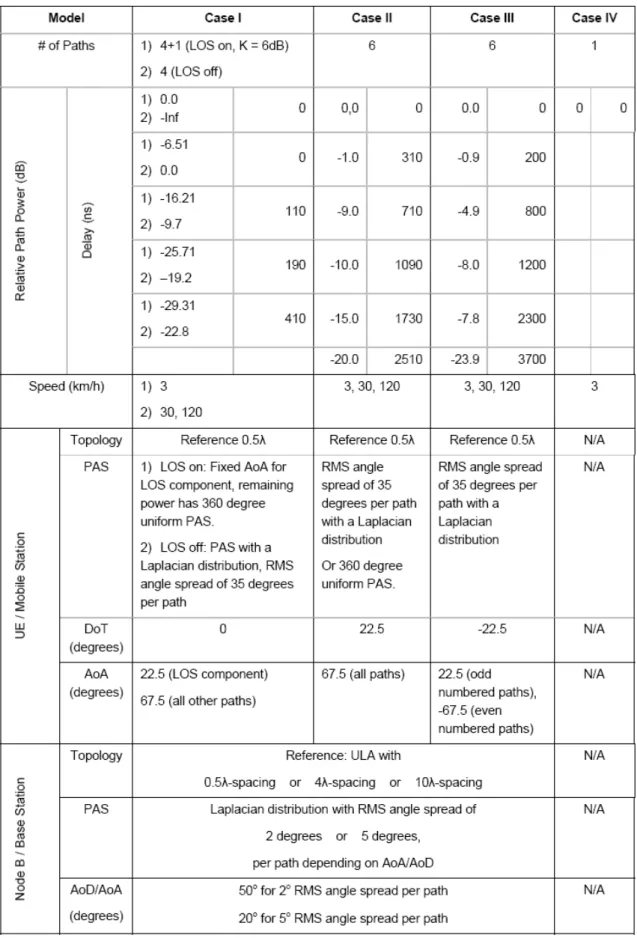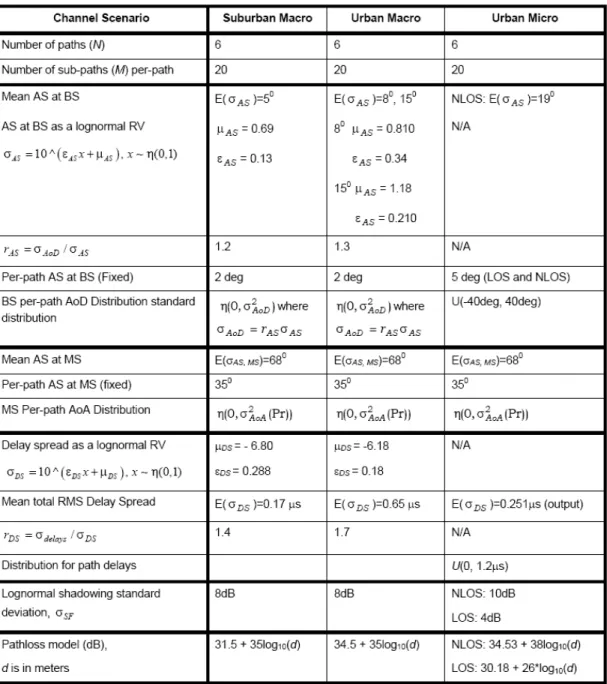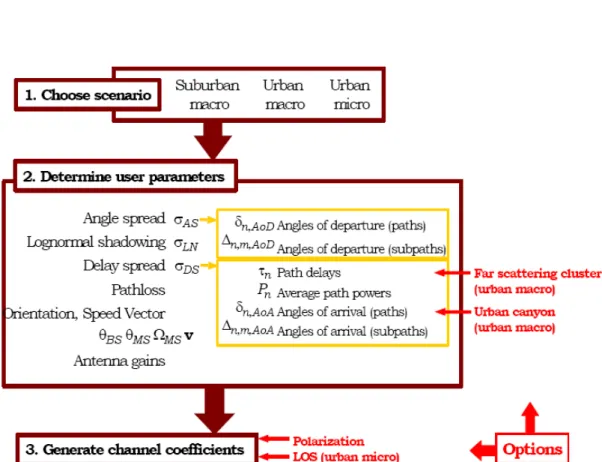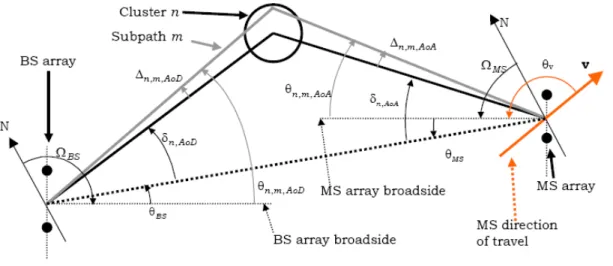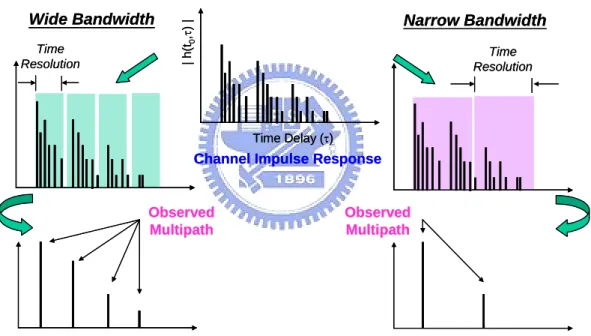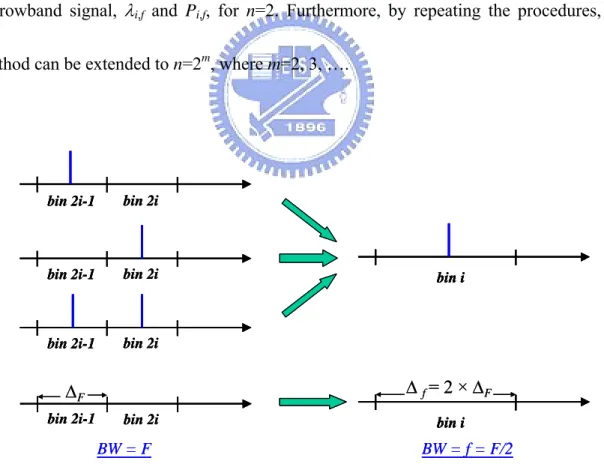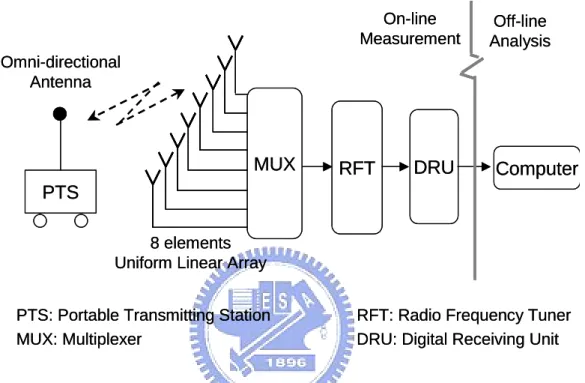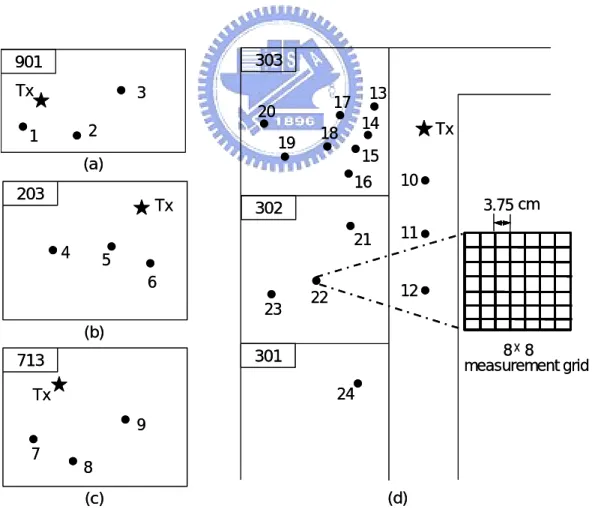國 立 交 通 大 學
電信工程學系
博 士 論 文
頻寬-空間-極化於寬頻多輸入多輸出無線電
通道影響之研究
Effects of Bandwidth-Space-Polarization on
UWB/Wideband Multiple-Input Multiple-Output
Channels
研 究 生:張維儒
指導教授:唐震寰 博士
頻寬-空間-極化於寬頻多輸入多輸出無線電
通道影響之研究
Effects of Bandwidth-Space-Polarization on
UWB/Wideband Multiple-Input
Multiple-Output Channels
研究生:張維儒
Student:
Wei-Ju
Chang
指導教授:唐震寰 博士 Advisor:
Dr.
Jenn-Hwan
Tarng
國立交通大學
電信工程學系
博士論文
A Dissertation
Submitted to Institute of Communication Engineering
College of Electrical and Computer Engineering
National Chiao Tung University
in Partial Fulfillment of the Requirements
for the Degree of Doctor of Philosophy
in
Communication Engineering
Hsinchu, Taiwan
頻寬-空間-極化於寬頻多輸入多輸出無線電
通道影響之研究
研究生:張維儒 指導教授:唐震寰 博士
國立交通大學電信工程學系
中文摘要
為滿足下一代(B3G)無線通信系統的高傳輸速率需求,使用高頻寬並搭配多輸入多 輸出(MIMO)天線技術是未來無線通信系統的發展趨勢,而其通道特性的掌握與適當模 型的建構更是B3G 無線通信系統發展之初的首要課題。 對寬頻MIMO 通道而言,頻寬、天線間距及天線極化是影響其通道模型參數的主 要因子。頻寬的增加代表系統時間解析度變好,多路徑延遲(multipath delay)及群聚 (clustering)現象越明顯,窄頻之多路徑延遲模型必須修正以滿足寬頻系統通道之需 求;而在多天線部份,除空間天線陣列架構外,極化天線的應用有助於在無線終端設 備上實現多天線架構,因此,完整考量Space-Polarization 相關性的 MIMO 通道模型, 是MIMO 技術設計發展所必需。本論文完整探討Bandwidth-Space-Polarization 對寬頻 MIMO 通道之影響,發展一 創新之寬頻通道模型參數預估方法,可由窄頻通道模型參數預估寬頻通道參數模型。 另外吾人也針對室內環境,發展三維空間幾何散射模型,該模型結合幾何圓模型與幾 何橢圓模型之概念並將之拓展至三維空間,可用以模擬空間/極化陣列天線 MIMO 通 道的相關性。除此,吾人也透過實測數據分析,探討 UWB-MIMO 於身域環境(BAN) 之效能。本研究所發展之寬頻通道模型參數預估方法與MIMO 通道相關性模型,皆經 由實測數據分析獲得驗證,實測環境包含室外寬頻(120 MHz)、室內及身域環境之超寬 頻(3-10 GHz 頻段)通道量測,完全符合下一代無線通信系統之需求。
Effects of Bandwidth-Space-Polarization on
UWB/Wideband Multiple-Input
Multiple-Output Channels
Student:
Wei-Ju
Chang Advisor:
Dr.
Jenn-Hwan
Tarng
Institute of Communication Engineering
National Chiao Tung University
Abstract
To achieve high data rate requirements of systems beyond 3rd generation (B3G),
development and standardization of enhanced radio access technologies with wide
bandwidth and multiple-input multiple-output (MIMO) antennas are sustained. In wireless
communication systems, radio channels play an important role on system performance.
Therefore, a through understanding of wideband MIMO channel characteristics is essential
for B3G wireless systems developing and realization.
Compared to traditional narrowband single-input single-output (SISO) channels,
bandwidth, array spacing and antenna polarization effects should be taking into account in
to observe more multipath components, and therefore stronger clustering effects due to its
better time resolution. For MIMO systems, in addition to spatial arrays, the utilization of
polar arrays is of great interest recently due to its benefit to the device compactness.
Therefore, a complete MIMO channel model should include the space factor as well as the
polarization factors.
In this research, effects of bandwidth-space-polarization on UWB/wideband MIMO
channels are investigated. Here, a novel method for wideband model parameters estimation
is developed. Through this method, the model parameters of a wideband signal can be
determined from those of a narrowband signal. Furthermore, a three-dimensional
Geometrically Based Single Bounce Model (3D GBSBM), is proposed for indoor wideband
MIMO channel correlation modeling. This model is extended from a 2D model, which
combines the concept of the Geometrically Based Single Bounce Circle Model (GBSBCM)
and the Geometrically Based Single Bounce Ellipse Model (GBSBEM). In this model, the
effect of 3D multipath on sub-channel correlation of the spatial/polar arrays is taken into
account. Finally, the performance of UWB-MIMO for body area networks (BANs) is
investigated through channel measurements.
The newly developed method and models are validated by broadband channel
(120-MHz bandwidth) measurements in outdoors as well as ultra-wideband channels (3-10
誌
謝
本論文得以順利完成,有賴生命中許許多多貴人的指導、協助、包容與相伴,於 此,以感恩之心,謹將此論文獻給您們! 首先,我要以最誠摯的敬意感謝我的指導老師 唐震寰教授,承蒙老師自大學、碩 士至博士多年來的指導,讓我在無線電傳播的專業知識領域多有成長,並能在相關研 究上有所突破,老師嚴謹認真的治學精神與謙沖的待人處事態度更是學生的典範。 其次,本論文相關研究工作得以順利進行,也有賴實驗室瑞榮學長的指導,以及 學弟妹豐誠、鳴君、孟勳、思云等人的共同努力,感謝他們。當然,也要特別感謝梁 小姐麗君多年來在各項事務上的熱心協助。 另外,也要感謝本論文的口試委員李大嵩教授、李學智教授、張道治教授、彭松 村教授、楊成發教授,能在百忙當中撥冗費心審查,對論文內容提出懇切的意見與指 導,讓本論文能更臻完善。 於此,也要特別感謝陳榮義主任的提攜與推薦,讓我有機會完成博士學位的進修。 計畫主管與同事在工作上給予的包容與協助,我更是銘感於心,每位同事的專業素養, 也讓我在通訊知識上能不斷成長。 最後,我要將此喜悅與我最親愛的家人分享。母親自小全心全意的照顧與教誨, 讓我能以樂觀進取之心平順克服學業與職場的挑戰,而我親愛的老婆欣怡與女兒詠 瑜,更是我精神上最大的支柱,有妳們陪伴的每一天,生活中總是歡樂喜悅與滿滿的 幸福,我愛妳們也謝謝妳們。Contents
中文摘要 ... III Abstract ... V 誌 謝 ...VII Contents... VIII List of Tables... X List of Figures ... XI Abbreviations... XV Chapter 1 Introduction ...11.1 Motivation and Contributions...2
1.2 Thesis Overview ...5
Chapter 2 Overview of Channel Models for B3G Systems...7
2.1 Introduction...8
2.2 Multipath models for wideband channels ...10
2.2.1 ∆-K model ...11
2.2.2 Saleh-Valenzuela model ...13
2.3 Spatial channel models ...16
2.3.1 Overview of Developed Spatial Channel Models ...16
2.3.2 MIMO Channel Models in Standards...22
Chapter 3 Measurement and Modeling of Wideband SISO Channels ...32
3.1 Introduction...33
3.2 A novel method for wideband model parameter estimation ...34
3.2.1 Bandwidth on observable multipath-clustering...35
3.2.2 Bandwidth on multipath power decay and amplitude fading...39
3.3 Measurement setup and environments...44
3.3.1 Outdoor environments ...44
3.4 Validation and Discussions ...50
3.4.1 Measurement data processing and analysis...50
3.4.2 Validation Results...54
3.5 Summary ...68
Chapter 4 Measurement and Modeling of Space Correlation for Indoor Wideband MIMO Channels...69
4.1 Introduction...70
4.2 A New Model for Wideband MIMO Channel Correlation ...72
4.2.1 3D Geometrically Based Single Bounce Model...74
4.2.2 Space Correlation of Spatial/Polar Arrays...78
4.3 Measurement and Validation...87
4.3.1 Measurement Setup and Environment ...87
4.3.2 Validation and Discussions...90
4.4 Summary ...95
Chapter 5 Measurements and Analysis of UWB MIMO Performance for Body Area Network Applications ...96
5.1 Introduction...97
5.2 Measurement Setup and Sites ...99
5.3 Observations and Discussions...103
5.3.1 Effect of Propagation Condition...104
5.3.2 Effect of Bandwidth ...105
5.3.3 Effect of Array Spacing ...107
5.3.4 Effect of Antenna Polarization ... 110
5.4 Summary ... 113
Chapter 6 Conclusions ...114
References ...118
List of Tables
Chapter 2 Overview of Channel Models for B3G Systems………..7
Table 2-1 The channel parameters of 3GPP SCM for link level simulations…… 28
Table 2-2 The channel parameters of 3GPP SCM for system level simulations…29 Table 2-3 Sub-paths to mid-paths assignment and resulting angle spread in 3GPP SCME……….……. 30
Chapter 3 Measurement and Modeling of Wideband SISO Channels………. 32
Table 3-1 Setup and environments for the broadband outdoor channel measurements……….………... 46
Table 3-2 Values of me-λ, σe-λ, me-P and σe-P for n=2……….. 61
Table 3-3 Values of me-λ, σe-λ, me-P and σe-P for n=4……….. 61
List of Figures
Chapter 1 Introduction………...1
Fig. 1-1 A diagram of 3GPP standard evolution….………...….4
Chapter 2 Overview of Channel Models for B3G Systems………..7
Fig. 2-1 The illustration of the ∆-K process……….………... 13
Fig. 2-2 The illustration of exponential decay of mean cluster power and ray power within clusters………. 15
Fig. 2-3 The illustration of the geometry of Lee’s model………. 17
Fig. 2-4 The illustration of the geometry of GBSBCM……… 18
Fig. 2-5 The illustration of the geometry of GBSBEM………. 20
Fig. 2-6 The illustration of the procedure for generating MIMO channels………... 30
Fig. 2-7 The illustration of multipath angle parameters at BS and MS sides…….... 31
Fig. 2-8 A diagram of the mid-path approach of SCME………... 31
Chapter 3 Measurement and Modeling of Wideband SISO Channels………. 32
Fig. 3-1 A diagram for bandwidth effect on the observed multipath propagation channels………34
Fig. 3-2 A diagram for the arrival of multipath when bandwidth changes from F to f for n=2……….…..38
Fig. 3-3 The averaged power delay profile of a 500 MHz-bandwidth UWB signal at an indoor environment and under NLOS condition. The wavy line shows the measured profile. The straight line, which is obtained by a best-fit procedure, represents an exponential decay line………. 40
Fig. 3-4 Rician factors of the first 15 bins of each measured point at indoor environments with 2-GHz bandwidth are shown. The total numbers of measured points are 24……… 41
Fig. 3-6 Schematic diagram of the UWB indoor channel measurement system….. 49 Fig. 3-7 Layouts of four sites where the UWB indoor channel measurements were
performed. Locations of the transmitter (Tx) and the receiver are shown by “Ì” and “•”, respectively………... 49 Fig. 3-8 Comparisons of the measured and computed results of (a) the path arrival
rate λi; and (b) the path occurrence probability Pi of “Urban 1” site with 60-MHz bandwidth for n=2……… 58 Fig. 3-9 Comparisons of the measured and computed results of (a) the path arrival
rate λi; (b) the path occurrence probability Pi of “Indoor NLOS” site with 1 GHz bandwidth for n=2……… 59 Fig. 3-10 Comparisons of the measured and computed results of (a) the path arrival
rate λi; (b) the path occurrence probability Pi of “Urban 1” site with 120 MHz bandwidth for n=4……….. 60 Fig. 3-11 The measured ki of “Indoor NLOS” site with 1 GHz bandwidth………...62 Fig. 3-12 K value of the measurement sites: (a) outdoor environments; and (b)
indoor environments……… 63 Fig. 3-13 Decay constant versus measured point number for signal bandwidths of
500MHz, 1GHz, and 2GHz at “Indoor LOS” and “Indoor NLOS” sites… 65 Fig. 3-14 Power ratio versus measured point number for signal bandwidths of 500
MHz, 1GHz, and 2GHz at “Indoor LOS” and “Indoor NLOS” sites…….. 66 Fig. 3-15 Comparisons between the measured and computed results of the power
ratio for all measured points at “Indoor LOS” and “Indoor NLOS” sites with 1GHz bandwidth……….. 66 Fig. 3-16 Rician factor versus measured point number for signal bandwidths of
500MHz, 1GHz, and 2GHz at “Indoor LOS” and “Indoor NLOS” sites… 67 Fig. 3-17 Comparisons between the measured and computed results of the Rician
factor for all measured points at “Indoor LOS” and “Indoor NLOS” sites with 1GHz bandwidth……….. 67
Chapter 4 Measurement and Modeling of Space Correlation for Indoor
Fig. 4-1 Per tap MIMO correlation metrics……….. 73 Fig. 4-2 The illustration of the geometry of the 3D GBSBEM………. 76 Fig. 4-3 Thr geometry for the scatter region of different taps………... 77 Fig. 4-4 The illustration of the geometry of the 3D GBSBM for the 1st tap: (a) the
effective scatter region; (b) the effective scatterers………. 77 Fig. 4-5 The illustration of the geometry of the 3D GBSBM for the 2nd tap: (a) the
effective scatter region; (b) the effective scatterers………. 78 Fig. 4-6 The geometrical configuration of a 1-by-2 channel of the 3D GBSBM…. 84 Fig. 4-7 The illustration of the 3D GBSBM in cylindrical coordinates……… 85 Fig. 4-8 The illustration of the 3D GBSBM for the nth tap………... 85 Fig. 4-9 The simulated spatial correlation of the co-polarized antenna case based
on the 2D GBSBM………... 86 Fig. 4-10 The simulated spatial correlation of the co-polarized antenna case based
on the 3D GBSBM for the 1st tap………. 86 Fig. 4-11 The simulated spatial correlation of the cross-polarized antenna case based
on the 3D GBSBM for the 1st tap………. 87 Fig. 4-12 The simulated spatial correlation of the cross-polarized antenna case based
on the 3D GBSBM for the 5th tap……… 87
Fig. 4-13 Layouts of the wideband MIMO channel measurement site………... 89 Fig. 4-14 The virtual antenna array configuration for MIMO channel
measurements………..……… 90 Fig. 4-15 The measured and fitted CDFs of the normalized power of the 1st tap…... 92 Fig. 4-16 The measured and fitted CDFs of the normalized power of the 2nd tap….. 92 Fig. 4-17 The measured and simulated space correlation of the 1st tap for
co-polarized antenna case……… 93 Fig. 4-18 The measured and simulated space correlation of the 2nd tap for
co-polarized antenna case……… 93 Fig. 4-19 The measured and simulated space correlation of the 1st tap for
cross-polarized antenna case……… 94 Fig. 4-20 The measured and simulated space correlation of the 2nd tap for
Chapter 5 Measurements and Analysis of UWB MIMO Performance for Body Area Network Applications………... 96
Fig. 5-1 Measured antenna return loss versus frequency………101 Fig. 5-2 The locations of Tx and Rx antennas for MIMO measurements………...101 Fig. 5-3 Floor layouts of measurement sites. (a) Sites A and B; (b) Site C……….102 Fig. 5-4 The measured 2×2 MIMO channel capacity at different sites for frequency
band of 3-10 GHz………...105 Fig. 5-5 The measured 2×2 MIMO channel capacity at site C………106 Fig. 5-6 One sub-channel frequency response at Site C………..106 Fig. 5-7 MIMO channel capacities versus receiving array spacing at Site A……..108 Fig. 5-8 Spatial correlation coefficients versus receiving array spacing at Site A..109 Fig. 5-9 Maximum value of the power differences between any two sub-channels
versus receiving and transmitting array spacing at Site A……….109 Fig. 5-10 The measured 2×2 MIMO channel capacity of the polar array and the
spatial array at Site C……….111 Fig. 5-11 Received power of V/V or V/H link versus frequency at Site C for (a)
Abbreviations
Abbreviation Description
3G third generation
3GPP 3rd generation partnership project 3GPP2 3rd generation partnership project 2
AoA angle of arrival
AoD angle of departure
aPDP averaged power delay profile
AS angle spread
B3G beyond third generation
BAN body area network
BS base station
DS delay spread
GBSBM geometrically based single bounce model
GBSBCM geometrically based single bounce circular model GBSBEM geometrically based single bounce ellipse model HSDPA high speed downlink packet access
IFFT inverse fast Fourier transform
i.i.d. independently and identically distributed iPDP instantaneous power delay profile
ISI inter-symbol interference
LOS line-of-sight
LTE long-term evolution
METRA multi-element transmit receive antennas
MIMO multiple-input multiple-output
MPC multipath component
MS mobile station
NLOS non line-of-sight
PDF probability density function
PDP power delay profile
S-V Saleh-Valenzuela
SCM spatial channel model
SCME spatial channel model extension
SF shadow fading
SISO single-input single-output
SNR signal-to-noise ratio
TDL tapped-delay-line
TOA time of arrival
ULA uniform linear array
UWB ultra-wideband
VAN vector network analyzer
WAN wide area network
WLAN wireless local area network
Chapter 1 Introduction
In this chapter, the motivation and contributions of this research and the overview of this thesis are presented.
1.1 Motivation and Contributions
Recently, systems beyond 3G (B3G) have been actively discussed in various forum
and organizations. According to the ITU-R preliminary recommendation [1], new radio
interfaces of B3G systems will support high data rate transmissions up to approximately
100 Mbps for high mobility and 1 Gbps for low mobility, respectively. To achieve the high
data rate requirements, standardization and development of enhanced radio access
technologies with wide bandwidth and multiple antennas are sustained.
For instance, 3GPP is in the process of defining the long-term evolution (LTE) [2] and
LTE-Advanced for B3G services. Fig. 1-1 shows the evolution path of 3GPP standards.
Compared to the high-speed downlink packet access (HSDPA) [3] that introduced in 3GPP
release 5, LTE improves the downlink peak data rate from 14.4 Mbps to approximately 300
Mbps by using 4×4 multiple-input multiple-output (MIMO) antenna technologies along
with a wide bandwidth of 20 MHz, which is four times the bandwidth of HSDPA. In
addition to that, to meet the 1-Gbps peak data rate requirements of B3G systems, 3GPP
begins to process the feasibility studies of technologies using 8×8 MIMO along with a
bandwidth of 40 MHz. Furthermore, for short-range communications, ultra-wideband
(UWB) radio technology has attracted great interest in commercial and military sectors due
transmission bandwidth of 500 MHz at least [4].
The performance of wireless communications is greatly influenced by the radio
propagation channels. Consequently, a thorough understanding of UWB/wideband MIMO
channel characterizations is essential for the realization of B3G systems. To model
UWB/wideband MIMO channels, the statistical properties in frequency (bandwidth) and
spatial domains have to be carefully investigated. Furthermore, cross-polarized antennas
are of interest for MIMO applications due to its potential benefit for the device
compactness. Therefore, a complete investigation of UWB/wideband MIMO channels
should cover the characterizations and effects of bandwidth, space and polarization, which
is also the goal of this research.
For bandwidth effect, our major contribution is to develop a novel method to estimate
the model parameters of a wideband signal from those of a narrowband signal. Through
this approach, the proper model parameters for B3G systems can be determined from those
of current models of 3G systems, which support system bandwidth up to 5 MHz.
Furthermore, for space and polarization effect on MIMO channels, a three-dimensional
Geometrically Based Single Bounce Model (3D GBSBM) is proposed for the space
correlation modeling of indoor wideband MIMO channels. This model is extended from a
2D model, which combines the concept of the Geometrically Based Single Bounce Circle
In this model, the effect of 3D multipath on sub-channel correlation of the spatial/polar
arrays is taken into account.
Finally, UWB-MIMO performance in body area networks (BAN) is investigated
through channel measurements. It is found that in BAN the MIMO channel capacity is
mainly determined by the power imbalance between sub-channels compared to the
sub-channel correlation for spatial arrays, which is different from that in wide-area
networks (WAN) and wireless local area networks (WLAN).
In this research, the newly developed method and models are validated by extensive
broadband channel (120-MHz bandwidth) measurements in outdoors as well as UWB
channels (3-10 GHz) in indoors and BANs, which is agreeable to the requirements of B3G
systems. HSPA HSPA HSPA+ HSPA+ LTE LTE LTE-Advanced LTE-Advanced 5 MHz 20 MHz 40+ MHz 1×2 SIMO 2×2 MIMO 4×4 MIMO 8×8 MIMO Bandwidth 14.4 Mbps 28 Mbps ~300 Mbps ~1 Gbps HSPA HSPA HSPA+ HSPA+ LTE LTE LTE-Advanced LTE-Advanced 5 MHz 20 MHz 40+ MHz 1×2 SIMO 2×2 MIMO 4×4 MIMO 8×8 MIMO Bandwidth 14.4 Mbps 28 Mbps ~300 Mbps ~1 Gbps
1.2 Thesis Overview
In Chapter 2, some of the well-known models for wideband multipath delay
propagations and for MIMO channels are introduced. For UWB/wideband propagations,
multipath arrivals in cluster rather than in continuum as is customary for narrowband
channels. The ∆-K model [5] and the Saleh-Valenzuela (S-V) model [6] are two
well-recognized models to characterize the multipath-clustering phenomenon in delay
domain. For MIMO channels, correlation between sub-channels, which is dependent on the
multipath power-angle spectrum and array architecture, is significant to MIMO channel
capacity. The spatial channel models proposed in IEEE 802.11n [7] and 3GPP/3GPP2 [8]
are two representative models for MIMO channels in indoor and cellular environments,
respectively.
In Chapter 3, measurement and modeling of UWB/wideband multipath channels for
single-input single-output (SISO) is described. Here, a novel method is proposed to
estimate the model parameters of a wideband signal from those of a narrowband signal.
Through this approach, effect of bandwidth on the observable multipath-clustering is
explored. Our proposed method is extensively validated by measured channels of 1.95
GHz and 2.44 GHz broadband radios in metropolitan and suburban areas, and of 3-5 GHz
In Chapter 4, a newly developed 3D GBSBM for indoor environments is introduced.
Based on this model, we derived the correlation between MIMO sub-channels of
spatial/polar arrays and discuss its sensitively to a variety of different azimuth and
elevation angle spreads. By combining this 3D GBSBM scattering model with the
deterministic rays, site-specific indoor MIMO channels are well modeled.
In Chapter 5, the performance of UWB-MIMO applications in BANs in presented.
Here, the effects of bandwidth, array spacing, and antenna polarization on UWB-MIMO
channel capacity are experimentally investigated and discussed.
Chapter 2 Overview of Channel
Models for B3G Systems
In this chapter, first the well-known models for multipath-clustering are introduced. Then some MIMO channel models presented in literature and standards are introduced.
2.1 Introduction
Because of multipath propagation due to reflections, refractions, and/or scattering by
obstacles or scatters in propagation environments, radio propagation channels are usually
modeled as a linear filter with a complex-valued lowpass equivalent impulse response that
is expressed as
( )
=∑(
−)
k k k
a
hτ δ τ τ (2-1)
where ak and τk are the random complex-valued path gain and propagation delay of the
multipath components (MPCs), respectively; and δ is the Dirac delta function. However, in
practice, bandwidth of a signal is finite consequently the multipath resolution duration is
nonzero and is equal to the reciprocal of the signal bandwidth. Therefore, the number of
resolved multipath and its path gain is dependent on signal bandwidth.
In addition to the time dispersion phenomenon, angular dispersion effects are
described by the double-directional channel impulse response [9]
(
)
(
) (
l) (
l)
l l l
a
hτ, ,φ ψ =∑ δ τ−τ δ φ−φ δψ −ψ (2-2)
departure (AoD) and the angle of arrival (AoA), respectively. It is noted that the
double-directional channel impulse response describes only the propagation channel and is
thus independent of antenna.
For MIMO systems, the channel response has to be described for all transmit and
receive antenna pairs. Let us consider MIMO system with m transmit antennas and n
receive antennas, then the time-invariant MIMO channel is represented by a n×m channel
matrix:
( )
( )
( )
( )
( )
( )
( )
( )
( )
( )
⎟⎟ ⎟ ⎟ ⎟ ⎟ ⎠ ⎞ ⎜ ⎜ ⎜ ⎜ ⎜ ⎜ ⎝ ⎛ = τ τ τ τ τ τ τ τ τ τ nm n n m m h h h h h h h h h 2 1 1 22 21 1 12 11 K M O M M K K H (2-3)where, hij(τ) denote the impulse response between the jth transmit antenna and the ith
receive antenna. It is noted that hij(τ) includes the effects of propagation channel and
antennas. The relationship between hij(τ) in (2-3) and h(τ, φ, ψ) in (2-2) is shown as
( )
τ(
( ) ( )
τ φ ψ)
( )
φ( )
ψ ϕ ψ φ ψ d d G G h hij = ∫ ∫ rTxj ,rRxi , , , Tx Rx (2-4)where, r(j)Tx and r(j)Rx are the coordinates of the jth transmit and ith receive antenna,
pattern, respectively.
For cross-polarized antenna applications, the polarization can be take into account by
extending the impulse response to a polarimetric (2×2) matrix [10] that describes the
coupling between vertical (V) and horizontal (H) polarizations:
(
)
(
)
(
)
(
)
(
)
(
) (
l) (
l)
l HV lHH l l VH l VV l HH HV VH VV a a a a h h h h ψ ψ δ φ φ δ τ τ δ ψ φ τ ψ φ τ ψ φ τ ψ φ τ ψ φ τ − − − ⎟⎟ ⎟ ⎠ ⎞ ⎜⎜ ⎜ ⎝ ⎛ = ⎟ ⎟ ⎠ ⎞ ⎜ ⎜ ⎝ ⎛ = ∑ pol , , , , , , , , , , H (2-5)From (2-4) and (2-5), it is found that the bandwidth, array spacing and antenna
polarization effects should be taking into account in the modeling of wideband MIMO
channels.
2.2 Multipath models for wideband channels
For narrowband/wideband radio channels, the tapped-delay-line (TDL) model is a
well-recognized model for multipath delay propagations. In this model, the axis of excess
delay times is partitioned into bins and the bin width is equal to the reciprocal of the signal
bandwidth. It assumes multipath arrive at every bins with average power profile that
Multipath-clustering, the phenomenon that multipath arrivals in cluster, has been
found in outdoor broadband channels as well as in indoor UWB channels [5-6, 11-16]. It is
caused by the fact that scatterers tend to group together in realistic environments and are
resolved in groups by the system with fine or very fine time resolution. Modeling of this
phenomenon helps the design of an equalizer or Rake receiver, such as design of equalizers
with unequal tap spacing or design of a selective Rake receiver and partial Rake receivers
[12]. In addition, in [17], it shows that unclustered models tend to overestimate the channel
capacity as comparing with the case that multipath components are indeed clustered. Here,
tow well-recognized models to characterize the multipath-clustering phenomenon, the ∆-K
model and the S-V model, are introduced.
2.2.1
∆-K model
The ∆-K model is initiated by Turin et al. [18], [19] and developed by Suzuki [5] to
describe the ToAs of MPCs by taking multipath-clustering into account. In the model, the
axis of excess delay times (relative to the propagation delay of the direct path between
transmitting and receiving antennas) is partitioned into bins with width ∆ [5]. The
probability of having a path in bin i is a function of whether or not an arrival occurred in
the previous bin, and is a function of the empirical probability of path occurrences at
of Fig. 2-1: the probability of having a path in bin i is equal to λi if there is no path in the
(i-1)st bin; otherwise, it is increased by a factor K due to multipath-clustering effect. Note
that, both the path occurrence probabilities, λi and K⋅λi, are equal to or less than 1. When K
>1, the process exhibits a clustering property and large K represents a large clustering
effect. For K=1, this process reverts to a standard Poisson process.
It is noted that this model is applicable upon replacing K by ki, which is a function of
the bin number i [5, 20-21]. From the branching process shown in Fig. 2-1 with replacing
K by ki, it is found that, Pi, the probability of having a path in bin i, is equal to the sum of
the probabilities (1-Pi-1)⋅λi and Pi-1⋅ki⋅λi. After some derivations, λi is given as
2 , 1 1 ⋅ 1+ ≥ − = − i P k P i i i i ) ( λ (2-6) where λ1 = P1.
It is noted that ∆ is a model parameter to be chosen [5,18]. However, according to the
assumption in these papers that each bin contains either one path or no path, it is
reasonable to set ∆ as the signal time resolution, which is reciprocal of the signal
bandwidth, of the specific radio system [11, 21-22]. This is because two or more paths
arriving within the same time resolution interval cannot be resolved as distinct paths for a
bandwidths may observe different multipath-clustering phenomenon and yield different
channel model parameters for a specific environment because that the number of
resolvable MPCs and clusters are changed with signal time resolution.
1 λ
…
…
…
…
…
…
…
…
…
…
…
…
..
..
..
.
∆
bin 1 bin 2 bin 3 bin 4
1 1−λ 2 λ K 2 1−Kλ 2 λ 2 1−λ 3 λ K 3 1−Kλ 3 λ 3 1−λ 3 λ K 3 1−Kλ 3 λ 3 1−λ 4 λ K 4 1−Kλ 4 λ 4 1−λ 1 λ
…
…
…
…
…
…
…
…
…
…
…
…
..
..
..
.
∆
bin 1 bin 2 bin 3 bin 4
1 1−λ 2 λ K 2 1−Kλ 2 λ 2 1−λ 3 λ K 3 1−Kλ 3 λ 3 1−λ 3 λ K 3 1−Kλ 3 λ 3 1−λ 4 λ K 4 1−Kλ 4 λ 4 1−λ
Fig. 2-1 The illustration of the ∆-K process.
2.2.2 Saleh-Valenzuela model
The S-V model was introduced first by Saleh-Valenzuela [6] to characterize the
multipath-clustering phenomenon, and later verified, extended, and elaborated upon by
many other researchers in [14-15]. The major difference between S-V model and
time interval. Instead, two Poisson models are employed in the modeling of the arrival time.
The first Poisson model is for the first path of each path cluster and the second Poisson
model is for the paths (or rays) within each cluster. Following the terminology in [6], we
define
Tl = the arrival time of the first path of the l-th cluster;
τk,l = the delay of the k-th path within the l-th cluster relative to the first path arrival
time, Tl;
Λ = cluster arrival rate;
λ = ray arrival rate, i.e., the arrival rate of path within each cluster.
By definition, we have τ0l =Tl. The distribution of cluster arrival time and the ray
arrival time are given by (2-2) and (2-3), respectively
(
T T−1)
=Λ[
−Λ(
T −T −1)
]
l >0p l l exp l l , (2-7)
(
−1)
=[
−(
− −1)
]
k >0pτk,lτ(k ),l λexp λτk,l τ(k ),l , (2-8)
The magnitude of the k-th path within the l-th cluster is denoted by βkl. It is Rayleigh
distributed with a mean given by
( ) (
)
(
τ γ)
β
where Γ and γ are the cluster and ray decay constants, respectively. β2
( )
0,0 is the average power of the first arrival of the first cluster. Illustrations of the double exponentialdecay model in Fig. 2-2.
delay time
a
m
plitude
overall envelope
cluster envelope
cluster 1 cluster 2 cluster 3 ….. delay time
a
m
plitude
overall envelope
cluster envelope
cluster 1 cluster 2 cluster 3 …..
Fig. 2-2 The illustration of exponential decay of mean cluster power and ray power within clusters.
2.3 Spatial channel models
2.3.1 Overview of Developed Spatial Channel Models
A. Ray tracing models
In the past few years, a deterministic model, called ray tracing, has been proposed
based on the geometric theory and reflection and diffraction models. By using site-specific
information, this technique deterministically models the propagation channel, including the
path loss, the multipath delay and angle spread. However, the high computational burden
and lack of detailed terrain and building databases make ray tracing models difficult to use.
For computation efficiency, some physical-based models, such as Lee’s model and
geometrically based single bounce models, and analytical-based models, such as
correlation-based model, are developed.
B. Lee’s model
In Lee’s model, scatterers are evenly spaced on a circular ring about the mobile as
shown in Fig. 2-3 [23, 24]. Each of the scatterers is intended to represent the effect of
many scatterers within the region, and hence are referred to as effective scatterers.
Assuming that N scatterers are uniformly placed on the circle with radius R and
1 1 0 2 = − ⎟ ⎠ ⎞ ⎜ ⎝ ⎛ ≈ i i N N D R i sin , , ,K, π φ (2-10)
From the discrete AoAs, the correlation of the signals between any two elements of
the array can be found using
(
)
∑−[
(
)
]
= − + = 1 0 0 0 1 2 N i i d j N D R d θ π θ θ ρ , , , exp cos (2-11)where d is the element spacing and θ0 is measured with respect to the line between the two
elements as shown in Fig. 2-3.
C. Geometrically Based Single Bounce Circular Model
The Geometrically Based Single Bounce Circular Model (GBSBCM) is applicable to
macro-cell scenarios. The geometry of the GBSBCM is shown in Fig. 2-4. It assumes that
the scatterers lie within radius Rm about the mobile. Often the requirement that Rm < D is
imposed. Furthermore, it assumes that there is no scatterer near the base station since the
height of base station antenna is very large relative to scatterers in macro-cell environments.
The idea of a circular region of scatterers centered about the mobile was originally
proposed by Jakes [25] to derive theoretical results for the correlation observed between
two antenna elements. The joint ToA and AoA density function at the mobile unit is [26]
( )
(
)(
(
)
)
⎪ ⎩ ⎪ ⎨ ⎧ ≤ − − − + − − = otherwise 0 2 4 2 2 2 2 3 2 3 2 2 2 2 2 2 m m R c D c D c D R c c D c D c D f φ τ τ τ φ π τ φ τ τ φ τ φ τ cos cos cos , , (2-12)D. Geometrically Based Single Bounce Elliptical Model
For micro-cell environments where the base station antenna is at the same height as
the surrounding scatterers, the Geometrically Based Single Bounce Elliptical Model
(GBSBEM) is developed to take into account the effect of scatterers around the base
station antennas [27-28]. In the GBSBEM, it assumes that scatterers are uniformly
distributed within an ellipse, as shown in Fig. 2-5, where the base station and mobile are
the foci of the ellipse. The parameters am and bm are the semi-major axis and semi-minor
axis values, which are implicitly to delay of the maximum ToA to be considered, τm , by
2 2 2 2 b c D c am = τm , m = τm− (2-13)
where c is the speed of light.
A nice attribute of the elliptical model is the physical interpretation that only
multipath signals that arrive with an absolute delay τm are accounted for by the model.
Ignoring components with larger delays is possible since signals with longer delays will
experience greater path loss, and hence have relatively low power compared to those with
shorter delays.
( )
(
)(
(
)
)
⎪ ⎩ ⎪ ⎨ ⎧ ≤ < − + − − = otherwise 0 4 2 3 3 2 2 2 2 2 2 m m m c D c D b a c c D c D c D f π φ τ τ τ τ φ τ τ φ τ φ τ cos cos , , (2-14)In Chapter 4, a three-dimensional GBSBM which combines the concept of Lee’s
model, GBSBCM and GBSBEM, is proposed to derived the correlation of the signals
between any two elements of an spatial-/polar-array in pico-cell (indoor) environments.
Fig. 2-5 The illustration of the geometry of GBSBEM.
E. Correlation-based Models
In contrast to physical models, analytical channel models characterize the transfer
function of the channel between the individual transmit and receive antennas in a
mathematical/analytical way without explicitly accounting for wave propagation.
In [29-30], the European Union IST METRA (Multi-Element Transmit Receive
MIMO channels. In this model, it claims that the spatial cross correlation coefficient can be
expressed as the product of the correlations at transmitting and receiving side. i.e.,
Rx m m Tx n n l n m l n m n m n m H 1 1 H 1 1 1 2 1 2 1 1 2 2 2 2 ρ ρ ρ = , = (2-15)
which can be also written in matrix form as
Rx H Tx H H P P P = ⊗ (2-16)
where ‘⊗’ denotes the Kronecker product, PH is the power correlation matrix of the MIMO
channel, Tx H
P and PHTx are the power correlation matrices seen from the transmitter and
receiver, respectively.
According to the above description, the MIMO channel can be easily generated by
( )
Hl = Pl Czlvec (2-17)
where vec(X) is the operation of stacking the columns of a matrix X into a vector. zl is a
column vector (MN×1) with i.i.d. zero-mean complex Gaussian elements. C is a symmetric
matrix and the (x, y)th element of CCT equals the root of the power correlation coefficient
2.3.2 MIMO Channel Models in Standards
A. IEEE 802.11n spatial channel model
To enable multiple-input multiple-output (MIMO) antenna technologies in wireless
local area networks (WLAN), the task group n (TGn) of IEEE 802.11 standardization
group proposed a set of channel models applicable to indoor MIMO WLAN systems [7].
Some of the channel models are an extension of the SISO WLAN channel models, and a
newly developed multiple antenna models is based on the cluster model developed by
Saleh and Valenzuela [6].
In [7], six clustering delay profile models are proposed for different indoor
environments. The model parameters, such as number of clusters, number of taps in a
particular cluster, and power, angular spread (AS), angle-of-arrival (AoA), and angle of
departure (AoD) values of each tap are defined for each delay profile model. With the
knowledge of each tap power, AS, and AoA (AoD), for a given antenna configuration, the
channel matrix H can be determined.
The MIMO channel modeling approach, which is similar to the method presented in
[30-31] that utilizes receive and transmit correlation matrices. For a 4×4 array, the MIMO
channel matrix H for each tap can be separated into a fixed (constant, LOS) matrix and a
⎟ ⎟ ⎟ ⎟ ⎟ ⎠ ⎞ ⎜ ⎜ ⎜ ⎜ ⎜ ⎝ ⎛ ⎥ ⎥ ⎥ ⎥ ⎦ ⎤ ⎢ ⎢ ⎢ ⎢ ⎣ ⎡ + + ⎥ ⎥ ⎥ ⎥ ⎥ ⎦ ⎤ ⎢ ⎢ ⎢ ⎢ ⎢ ⎣ ⎡ + = ⎟ ⎟ ⎠ ⎞ ⎜ ⎜ ⎝ ⎛ + + + = 44 43 42 41 34 33 32 31 24 23 22 21 14 13 12 11 1 1 1 1 1 1 44 43 42 41 34 33 32 31 24 23 22 21 14 13 12 11 X X X X X X X X X X X X X X X X K e e e e e e e e e e e e e e e e K K P H K H K K P H j j j j j j j j j j j j j j j j v F φ φ φ φ φ φ φ φ φ φ φ φ φ φ φ φ (2-18)
where Xij (i-th receiving and j-th transmitting antenna) are correlated zero-mean, unit
variance, complex Gaussian random variables as coefficients of the variable NLOS
(Rayleigh) matrix HV, exp(jφij) are the elements of the fixed LOS matrix HF, K is the
Rician K-factor, and P is the power of each tap. To correlate the Xij elements of the matrix
X, the following method can be used
[ ] [ ] [
][ ]
(
)
T tx iid rx H R R X = 12 12 (2-19)where Rtx and Rrx are the receive and transmit correlation matrices, respectively, and Hiid is
a matrix of independent zero mean, unit variance, complex Gaussian random variables, and
⎥ ⎥ ⎥ ⎥ ⎦ ⎤ ⎢ ⎢ ⎢ ⎢ ⎣ ⎡ = 44 43 42 41 34 33 32 31 24 23 22 21 14 13 12 1 rx rx rx rx rx rx rx rx rx rx rx rx rx rx rx rx R ρ ρ ρ ρ ρ ρ ρ ρ ρ ρ ρ ρ ρ ρ ρ (2-20)
⎥ ⎥ ⎥ ⎥ ⎦ ⎤ ⎢ ⎢ ⎢ ⎢ ⎣ ⎡ = 44 43 42 41 34 33 32 31 24 23 22 21 14 13 12 1 tx tx tx tx tx tx tx tx tx tx tx tx tx tx tx tx R ρ ρ ρ ρ ρ ρ ρ ρ ρ ρ ρ ρ ρ ρ ρ (2-21)
where ρtxij are the complex correlation coefficients between i-th and j-th transmitting
antennas, and ρrxij are the complex correlation coefficients between i-th and j-th receiving
antennas.
The complex correlation coefficient values calculation for each tap is based on the
power angular spectrum (PAS) with angular spread (AS) being the second moment of PAS
[32-33]. Using the PAS shape, AS, mean angle-of-arrival (AoA), and individual tap power,
correlation matrices of each tap can be determined as described in [32]. For the uniform
linear array (ULA) the complex correlation coefficient at the linear antenna array is
expressed as ) ( ) (D jR D RXX + XY = ρ (2-22)
where D=2πd/λ, and RXX and RXY are the cross-correlation functions between the real
parts (equal to the cross-correlation function between the imaginary parts) and between the
∫ − = π π φ φ φ d PAS D D RXX( ) cos( sin ) ( ) (2-23) ∫ − = π π D φ PAS φ dφ D RXY( ) sin( sin ) ( ) (2-24)
B. 3GPP SCM/SCME channel model
To enable multiple-input multiple-output (MIMO) antenna technologies in cellular
systems, standardization groups 3GPP and 3GPP2 defined a spatial channel model (SCM)
[8] for cellular systems with bandwidths up to 5 MHz. Recently, for 3GPP long-term
evolution (LTE) standardization [2], an SCM extension (SCME) model including the
wideband spatial channel characteristics was proposed to support bandwidths up to 20
MHz.
In [8], the spatial channel models for link level and system level simulations are
defined. Link level simulations will not be used to compare performance of different
algorithms. Rather, they will be used only for calibration, which is the comparison of
performance results from different implementations of a given algorithm. Table 2-1
summarizes the physical parameters to be used for link level modeling. The MIMO
channel matrix generation method of the link level model is similar to that described in
As opposed to link simulations which simply consider a single BS transmitting to a
single MS, the system simulations typically consist of multiple cells/sectors, BSs, and MSs.
Fig. 2-6 shows a roadmap for generating the channel coefficients. It defines three
environments (suburban macro, urban macro, and urban micro) where urban micro is
differentiated in line-of-sight (LOS) and non-LOS (NLOS) propagations. Detailed model
parameters are listed in Table 2-2. In each environment, the number of paths is equal to 6.
Each path is further composed of 20 spatially separated sub-paths to produce a Rayleigh
fading envelope. The main characteristics of the model include a narrow angle spread (AS)
per-path, with specific base station angle of departure (AoD) and mobile station angle of
arrival (AoA) models. The large-scale behaviors, described by the composite AS, DS and
shadow fading (SF), are simultaneously correlated in the log-normal domain to produce the
expected channel characteristics for each realization of the channel. Path powers, path
delays, and angular properties for both sides of the link are modeled as random variables
defined through probability density functions (PDFs) and cross-correlations.
For an S element linear BS array and a U element linear MS array, the channel
coefficients for one of N multipath components are given by a U-by-S matrix of complex
amplitudes. Denote the channel matrix for the nth multipath component (n = 1,…,N) as
) (
(
)
(
[
(
)
]
)
(
)
(
(
)
)
(
)
(
)
∑ = ⎟⎟ ⎟ ⎟ ⎟ ⎟ ⎠ ⎞ ⎜⎜ ⎜ ⎜ ⎜ ⎜ ⎝ ⎛ − × × Φ + = M m v AoA m n AoA m n u AoA m n MS m n AoD m n s AoD m n BS SF n n s u t jk jkd G kd j G M P t h 1 θ θ θ θ θ θ σ , , , , , , , , , , , , , cos v exp sin exp sin exp ) ( (2-25)where the angular parameters are shown in Fig. 2-7.
The 3GPP SCME is an extension to the SCM for bandwidths up to 20 MHz. In 3GPP
SCME, the 20 sub-paths of SCM are split into 3 subsets, denoted as mid-paths, which are
moved to different delays relative to the original path as shown in Fig. 2-8. The delays and
powers of these 3 mid-paths are predetermined by an exponential power decay function
with 10-ns delay spread. To keep the fading distribution close to Rayleigh, a mid-path is
lumped of 4 or more sub-paths. The mid-path ASs (ASi where i is the mid-path index) are
optimized such that the deviation from the path AS (ASn where n is the path index), i.e. the
AS of all mid-paths combined, is minimized. The delays and the corresponding sub-paths
Table 2-3 Sub-paths to mid-paths assignment and resulting angle spread in 3GPP SCME 1.0247 13, 14, 15, 16 25 ns 4 (of 20) 3 1.0056 9, 10, 11, 12, 17, 18 12.5 ns 6 (of 20) 2 0.9865 1, 2, 3, 4, 5, 6, 7, 8, 19, 20 0 10 (of 20) 1 Asi/ ASn Sub-paths Delay Number of sub-paths Mid-path 1.0247 13, 14, 15, 16 25 ns 4 (of 20) 3 1.0056 9, 10, 11, 12, 17, 18 12.5 ns 6 (of 20) 2 0.9865 1, 2, 3, 4, 5, 6, 7, 8, 19, 20 0 10 (of 20) 1 Asi/ ASn Sub-paths Delay Number of sub-paths Mid-path
Fig. 2-7 The illustration of multipath angle parameters at BS and MS sides.
Excess delay
Power
Path 4: composed of 20 zero-delay, spatially separated sub-paths
3 mid-paths with different relative delays
SCM: 6-path representation SCME: 6*3-path representation
Excess delay
Power
Path 4: composed of 20 zero-delay, spatially separated sub-paths
3 mid-paths with different relative delays
SCM: 6-path representation SCME: 6*3-path representation SCM: 6-path representation SCME: 6*3-path representation
Chapter 3 Measurement and Modeling
of Wideband SISO Channels
In this chapter, first our proposed method for wideband multipath model parameters estimation is described. We validate this method with extensive measurement data. The measurement setup and environments and the validation results are presented.
3.1 Introduction
In order to realize the B3G systems, a thorough understanding of the time dispersion
characteristics of radio multipath propagation channels is required. In high-speed wireless
data transmission, severe frequency-selective fading of multipath channel causes
inter-symbol interference (ISI) and leads to a significant problem for the systems. To solve
the problem, modeling of multipath time-of-arrival (TOA), particular on the
multipath-clustering phenomenon, is a fundamental and important work.
Although there are many researches focused on the exploration or modeling of
multipath-clustering phenomenon, few researches focused on the effect of signal
bandwidth on observed multipath-clustering so far. As shown in Fig. 3-1, it is easily
understood that in the observation of multipath-clustering of a radio channel using a
band-limited signal, the result is mainly affected by the signal resolution, which is the
reciprocal of the signal bandwidth. In this paper, based on the ∆-K model, newly formulas
are derived to describe the relationships between the observed TOA model parameters of
narrowband signals and those of wideband signals. Through this approach, effect of signal
bandwidth on the observable multipath-clustering is explored. Furthermore, to completely
characterize the time dispersion characteristics of the channel, a model using power ratio,
and amplitude fading is proposed. Formulas to relate these model parameters of a
wideband signal to those of a narrowband signal are also derived. Here, the model
parameter estimation methods have been extensively validated by comparing the computed
channel parameters with the ones extracted from the measured channel responses of 1.95
GHz and 2.44 GHz broadband radios in metropolitan and suburban areas, and of 3-5 GHz
UWB signals in indoors.
Time Delay (τ)
| h
(t0
,τ
) |
Channel Impulse Response Time
Resolution ResolutionTime
Observed Multipath
Observed Multipath
Wide Bandwidth Narrow Bandwidth
Time Delay (τ)
| h
(t0
,τ
) |
Channel Impulse Response Time
Resolution ResolutionTime
Observed Multipath
Observed Multipath
Wide Bandwidth Narrow Bandwidth
Fig. 3-1 A diagram for bandwidth effect on the observed multipath propagation channels.
3.2 A novel method for wideband model parameter estimation
To explore bandwidth dependency of the model parameters, which include the
clustering parameter, formulas to describe the relationships between observed model
model is adopted to characterize the multipath-clustering. It is noted that the bandwidth of
the wideband signal is confined to be n times of the narrowband signal’s, where n is a
positive integer. For convenience, the parameters with a subscript f or F correspond to
those of bandwidth f or F, respectively, where F=n⋅f.
3.2.1 Bandwidth on observable multipath-clustering
A. Formulas for wideband to narrowband
Since a bin width is inversely proportional to its signal bandwidth, ∆f is equal to n⋅∆F,
where ∆f and ∆F are the bin widths of the systems with signal bandwidths f and F,
respectively. Therefore, when a received path occurs at bin i of a signal with bandwidth f,
the path should arrive at one or more of the bins covering from the (n⋅i-n+1)th bin to the
(n⋅i)th bin, for the signal with bandwidth F, which is due to the increase of time resolution
interval. Fig. 3-2 shows an example of n=2.
With the above analysis, λi,f and Pi,f are derived in terms of λj,F and Pj,F by (3-1) and
(3-2), respectively. ) 1 1 1 A r F n r f i, ( + , = ∏ − − = λ λ (3-1) where A= n⋅i-n.
(
)
(
)
⎪ ⎪ ⎪ ⎪ ⎩ ⎪⎪ ⎪ ⎪ ⎨ ⎧ ⎪⎩ ⎪ ⎨ ⎧ ≥ ⎪⎭ ⎪ ⎬ ⎫ ⎥ ⎦ ⎤ ⎢ ⎣ ⎡ − + − + = − + = ∑ ∏ = + = + − + + + + + + 3 ) 1 1 2 1 3 3 1 2 1 1 2 1 1 n P P n P P P n r A s F r s F r A F A F A F A F A F A F A f i , ( , , , , , , , , , , λ λ λ λ (3-2)Substituting λi,f and Pi,f into (2-6), ki,f is obtained. Here, let n=2, the analytical
relationship between ki,f and k2⋅i-1,F is found and written as
(
)
(
)
[
(
(
)
)
]
(
)
[
]
(
)
[
i- ,F i- ,F i- ,F]
,F i-,F i-,F i-,F i-,F i-i,F ,F i-i,F i,F ,F i-F i f i P P P P k k k 3 2 2 2 3 2 3 2 2 2 3 2 2 2 2 2 2 1 2 2 2 1 2 1 2 1 1 1 1 1 1 ⋅ − ⋅ + ⋅ ⋅ − ⋅ + ⋅ ⋅ ⋅ ⋅ ⋅ ⋅ ⋅ − ⋅ + ⋅ ⋅ − ⋅ ⋅ − ⋅ = − − λ λ λ λ λ λ λ λ , , (3-3)On the right-hand side of (3-3), magnitudes of the second and third factors are in the
range of 0 to 1. From (3-3), it is found that ki,f is smaller than k2⋅i-1,F if k2⋅i-1,F > 1. It means
that wider bandwidth signal observes stronger multipath-clustering phenomenon. It is
noted that k2⋅i-1,F ≅ k2⋅i,F, which is found from measurement data and is shown in Section
3-3.
B. Formulas for narrowband to wideband
With (3-1) and (3-2), the observed model parameters of a narrowband signal cannot
condition is needed to determine three unknown parameters, λ2⋅i-1,F, λ2⋅i,F and P2⋅i-1,F with
those of bandwidth f, λi,f and Pi, f. Here, the condition is given by assuming λ2⋅i-1,F =λ2⋅i,F,
i.e., the path arrival rates of two neighboring bins are equal. It is because that for both
outdoor broadband and indoor UWB radio channels, multipath excess delay time is much
larger than the time resolution (bin width). Based on this assumption, λ2⋅i-1,F and λ2⋅i,F are
solved from (3-1)
2 1
2i ,F λ i,F 1 1 λi,f
λ ⋅ − = ⋅ = − − (3-4)
However, our assumption may lead to underestimate λ2⋅i-1,F and overestimate λ2⋅i,F
since the path arrival rate decreased asymptotically with bin number. To reduce the
estimation errors, λ2⋅i-1,F and λ2⋅i,F from (3-4) are modified using the interpolation method
and are given by (3-5a) and (3-5b), respectively
(
)
⎭ ⎬ ⎫ ⎩ ⎨ ⎧ ⎥⎦ ⎤ ⎢⎣ ⎡ + ⋅ − = ⋅ − ⋅ − ⋅ + − ⋅ 1 2 1 2 1 2 1 2i ,F min 1, λ i ,F 41 λ i ,F λ i ,F λ (3-5a)(
2 1 2 1)
1 2 2⋅i,F =λ ⋅i− ,F −14⋅ λ ⋅i− ,F −λ ⋅i+ ,F λ (3-5b)It is noted that λ2⋅i-1,F and λ2⋅i+1,F on the right-hand side of (3-5a) and (3-5b) are
(
2) (
2)
1
2i F Pi f i F 1 i F
P ⋅ − , = , −λ ⋅ , −λ ⋅, (3-6a)
P2⋅i,F is computed by averaging its neighboring points and is given by (3-6b)
(
2 1 2 1)
2 2iF P i F P i FP⋅, = ⋅− , + ⋅+ , (3-6b)
Substituting λj,F and Pj,F into (2-6), kj,F is obtained. Through the above approaches, the
model parameters of a wideband signal, λj,F, Pj,F and kj,F, are determined by those of a
narrowband signal, λi,f and Pi,f, for n=2. Furthermore, by repeating the procedures, this
method can be extended to n=2m, where m=2, 3, ….
bin 2i-1 bin 2i
bin 2i-1 bin 2i
bin 2i-1 bin 2i
bin i
bin 2i-1 bin 2i bin i
BW = F BW = f = F/2
∆F ∆f= 2 ×∆F
bin 2i-1 bin 2i
bin 2i-1 bin 2i
bin 2i-1 bin 2i
bin 2i-1 bin 2i
bin 2i-1 bin 2i
bin 2i-1 bin 2i
bin i bin i bin i
bin 2i-1 bin 2i bin i
bin 2i-1 bin 2i bin ibin i
BW = F BW = f = F/2
∆F ∆f= 2 ×∆F
3.2.2 Bandwidth on multipath power decay and amplitude fading
To completely characterize the time dispersion characteristics of the channel, effects
of bandwidth on multipath averaged power decay and amplitude fading are analyzed as
follows.
A. A statistical model for multipath averaged power decay and amplitude fading
In many literatures for broadband and UWB radio channel modeling [34-35], the
small-scale averaged power delay profile (aPDP), g
( )
τ , is modeled by an exponential timedecay function with a stronger first bin and is expressed as
( )
( )
[
(
)
]
( )
⎥ ⎦ ⎤ ⎢ ⎣ ⎡ Γ − − + = ∑ = i L i i G g τ δ τ γ τ τ δ τ 2 2 1 1 exp (3-7)where G1 is the mean power of the first bin, τi is the relative time delay of bin i and is
equal to (i-1)⋅∆, γ is the power ratio that is defined as the ratio of the second bin’s mean
power to the first bin’s mean power, Γ is the exponentially power decay constant and δ is
the Dirac delta function. From our extended measurement data at indoor environments, one
of the examples shown in Fig. 3-3, it is found that this model well describes the measured
aPDP.
follows a Rician distribution with a large Rician factor and the later bins tend to follow the
Rayleigh statistics (the Rician factor is closed to zero), as shown in Fig. 3-4. It is noted that
measured points no.1-no.12 are in LOS (Line-of-Sight) situations and the rest points are in
NLOS (Non LOS) situations. Details of measurements are described later in Section 3.3.2.
Power ratio
Exponentially power decay
Power ratio
Exponentially power decay
Fig. 3-3 The averaged power delay profile of a 500 MHz-bandwidth UWB signal at an indoor environment and under NLOS condition. The wavy line shows the measured profile. The straight line, which is obtained by a best-fit procedure, represents an exponential decay line.
Fig. 3-4 Rician factors of the first 15 bins of each measured point at indoor environments with 2-GHz bandwidth are shown. The total numbers of measured points are 24.
B. Formulas for wideband to narrowband
For an uncorrelated scattered radio propagation channel [36], bins’ amplitudes are
distributed independently of one another, and the averaged bin power is calculated by the
power sum of multipath in a bin. For example, averaged power sum of two successive bins
for bandwidth F is equal to the averaged power of the corresponding bin for bandwidth f
